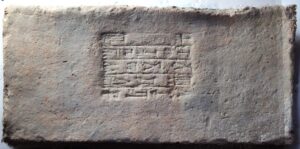
PROCEEDINGS OF THE NATIONAL ACADEMY OF SCIENCES—Researchers used baked bricks to reconstruct Earth’s magnetic field intensity in Mesopotamia during the first three millennia BCE. Archaeomagnetic techniques attempt to reconstruct the direction and intensity of Earth’s magnetic field over time and can be used to date archaeological materials. However, archaeomagnetic research is often limited by a dearth of data in certain regions and time periods. Matthew Howland and colleagues analyzed 32 inscribed baked bricks from Mesopotamia to produce precise archaeomagnetic datapoints spanning the third to first millennia BCE. During the kiln firing process, iron oxide minerals within the bricks record the intensity of Earth’s magnetic field at the time the bricks were made. The authors interpreted Sumerian and Akkadian inscriptions on the bricks and associated them with the reigns of 12 Mesopotamian kings, enabling dating at a higher resolution compared with radiocarbon methods. The results corroborate data from neighboring regions pertaining to a period of high geomagnetic field intensity from around 1050 to 550 BCE and known as the Levantine Iron Age geomagnetic anomaly. According to the authors, the findings provide insight into the dynamics of Earth’s magnetic field and establish a baseline for accurately dating archaeological materials from Mesopotamia during the first three millennia BCE, a region and period relevant for studies on the development of urbanism and social complexity.
__________________________________

A mudbrick dated to approximately 1800—1736 BCE, featuring an inscription that reads, “Palace of Iakūn-dīri son of Suma/tanim, king of the land Huršitum.” Matthew D. Howland
__________________________________
Article Source: PNAS news release.
*“Exploring geomagnetic variations in ancient mesopotamia: Archaeomagnetic study of inscribed bricks from the 3rd–1st millennia BCE,” by Matthew D. Howland et al., Proceedings of the National Academy of Sciences, 18-Dec-2023. https://www.pnas.org/cgi/doi/10.1073/pnas.2313361120
_______________________________
Advertisement

See the incredible archaeology, architecture, and art of northern Spain. A unique tour with special expert guides and lecturers through the collaboration of Popular Archaeology Magazine and Stone & Compass Tours. Not to be missed. Read More About It: https://popular-archaeology.com/article/northern-spains-triple-a-archaeology-architecture-and-art/.
__________________________________




